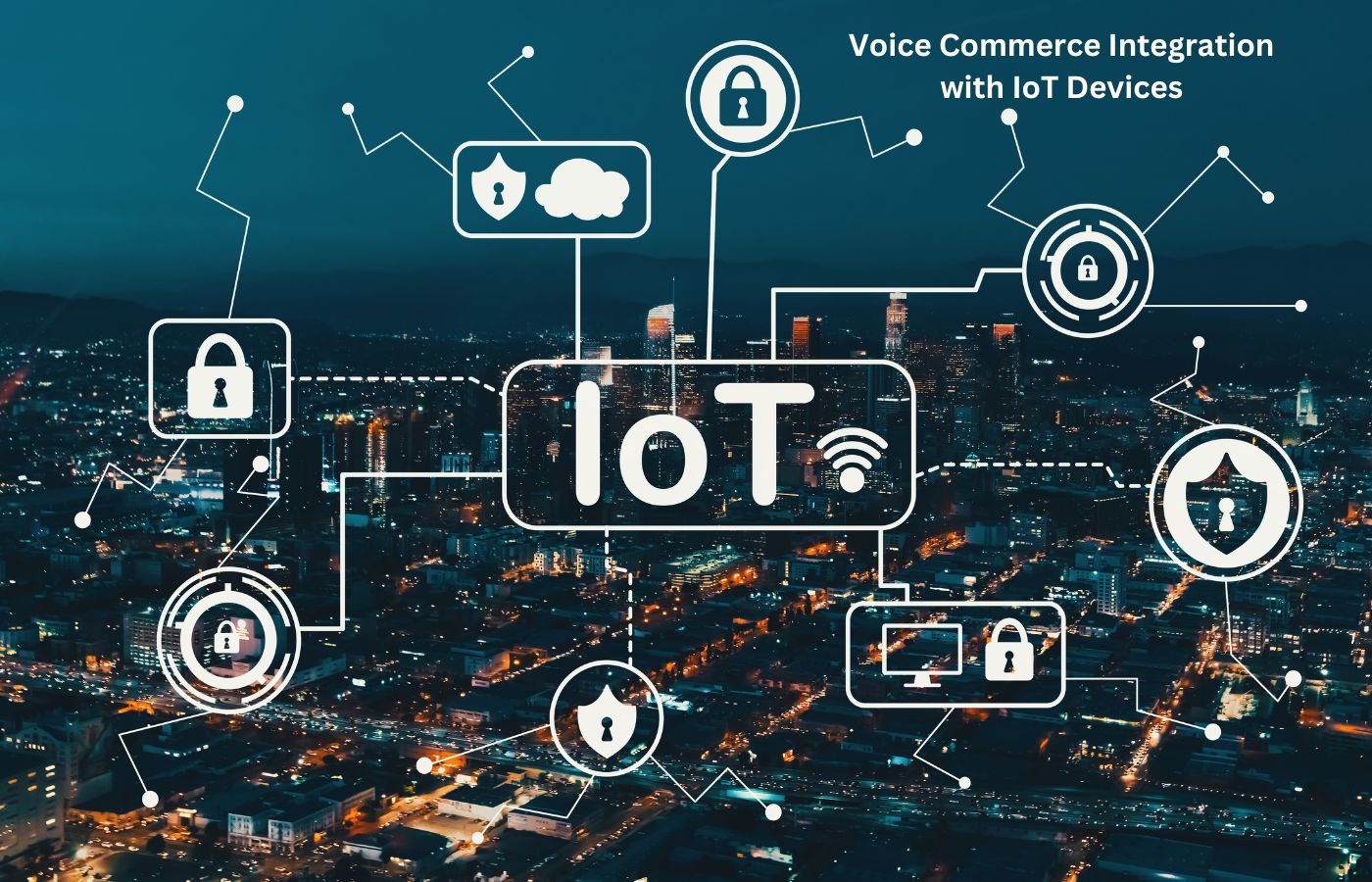Introduction – Voice Commerce
Voice Commerce, the revolutionary intersection between voice technology and online shopping, is rapidly revolutionizing retail. This technology utilizes advanced voice recognition to allow customers to complete shopping tasks through voice-enabled tasks or voice commerce, providing a quick, hands-free alternative to online shopping.
At the center of this revolution lie developments in Natural Language Processing (NLP), which have significantly enhanced systems’ abilities to comprehend and respond more accurately to complex human speech. As voice-activated devices become more ubiquitous in homes, their use makes voice commerce an integral part of daily life, providing multitasking capabilities and an enhanced user experience.
Personalization powered by artificial intelligence algorithms is essential in tailoring shopping experiences to individual preferences, leading to greater customer satisfaction and loyalty. With advancements in security measures and multi-language support, voice commerce promises to become an inclusive marketplace, breaking down barriers and expanding market reach.
This overview of voice commerce highlights key innovations driving its rise and promising to become as widespread as eCommerce today, ushering in a new era for how consumers interact with technology.
Advanced Natural Language Processing (NLP)

Advanced Natural Language Processing (NLP) is at the core of modern artificial intelligence, driving innovations beyond simple text and speech recognition. Modern NLP systems use deep learning – an AI subset that mimics neural networks found within human brains – to understand human language at both depth and context levels, allowing sophisticated applications like chatbots that maintain nuanced conversations and systems capable of summarizing extensive documents accurately.
One of the most significant advances in NLP is the creation of models capable of handling a range of language tasks. Modern NLP technologies such as transformer models (BERT and GPT) have set new standards in accuracy and efficiency, pre-trained on vast amounts of text before being fine-tuned for specific tasks; these models enable machines to understand the context better before producing human-like texts that reflect it.
NLP is now more accessible than ever thanks to frameworks and libraries that simplify building NLP models, providing developers and businesses access to sophisticated NLP solutions without needing deep expertise in their underlying technologies.
NLP technology has multiple practical uses that continue to expand. Within business environments, NLP provides companies with insights from previously too voluminous or complex data for manual analysis. From improving customer service with automated chatbots to extracting critical insights from unstructured data – NLP is becoming an indispensable technology.
NLP models continue to improve in accuracy and functionality as computational power increases and more nuanced models emerge, increasing their potential to understand human language better and interact more seamlessly. The ongoing evolution of NLP enhances how machines understand language and can assist people in making more informed decisions – leading to more intelligent AI systems.
Voice Commerce Integration with IoT Devices

The merging of voice commerce with Internet of Things (IoT) devices marks an innovative milestone in consumer behavior and technological capabilities, providing consumers with more intuitive ways of engaging with their environment via IoT devices such as smart speakers, home assistants, and connected appliances. Voice commerce thrives best on these IoT platforms that connect consumers more closely to their surroundings in more intuitive and hands-free ways.
Smart speakers like Amazon Echo and Google Home are central to this integration, acting as hubs for voice-enabled commands that allow users to perform various shopping-related activities without physically engaging with devices. A user can speak their order groceries, manage shopping lists, or track shipments, all without interrupting their daily household duties – further enhanced by devices’ learning from user interactions to learn about individual needs and preferences over time.
Integration goes beyond mere convenience; it improves functionality by connecting voice-enabled devices such as ovens or refrigerators with IoT capabilities to voice commands that link them together based on real-time inventory levels inside them. For instance, voice commands could prompt the preheating of an oven or add items to a shopping list based on inventory levels in real-time within your fridge based on instructions received through voice commands.
Voice commerce and IoT devices work hand in hand to provide consumers with an enhanced consumer experience while opening up new opportunities for businesses to deliver personalized, responsive services more cost-effectively and quickly. Furthermore, technological developments will bring greater integration between voice commerce and IoT devices that transform everyday tasks into interactive, efficient consumer experiences.
Personalization Engines

Voice commerce’s personalized shopping experiences have taken a quantum leap with personalization engines using advanced algorithms and machine learning to customize shopping experiences to individual preferences and behaviors. By mining vast amounts of user data, such as past purchases, search queries, browsing histories, etc., to build detailed customer profiles, personalization engines can then use this information to predict which products customers might like before they express an explicit desire for themselves.
This technology enhances voice shopping experiences in several ways. First, it creates a more natural and conversational interaction between customers and voice assistants; for instance, instead of browsing menus or typing searches directly into the voice assistant search bar, they can simply ask for recommendations tailored specifically to their tastes and behaviors. Not only does this save time, but it also makes the shopping experience engaging and less frustrating overall.
Personalization engines offer businesses an invaluable advantage in increasing conversion rates and customer retention. By providing products that are more likely to appeal, these engines increase the odds that a customer will make a purchase decision and improve customer satisfaction by making users feel understood and valued, ultimately leading to repeat engagements with the brand and stronger emotional connections between themselves and it.
As voice commerce continues to develop, personalization engines become ever more critical. They are not just selling tools; they’re essential in creating an experience that mirrors that of shopping at physical locations; this level of customization marks the future of retail by creating dynamic user experiences.
Enhanced Security Measures

Voice Commerce relies on enhanced security measures to safeguard sensitive customer information and establish trust between shoppers and vendors in this emerging shopping platform. As voice-activated devices become part of daily activities, protecting transactions and personal data becomes even more essential.
Voice biometrics has emerged as a groundbreaking development, using distinctive vocal characteristics to verify an individual’s identity beyond traditional passwords or PINs. Voice biometrics is particularly well suited for voice commerce as its authentication seamlessly blends in without disrupting user interactions.
Encryption is another critical security measure in place. Any data transferred between users and voice commerce systems – including payment information and personal details – is encrypted to protect against unauthorized access during transmission, using secure protocols like HTTPS and TLS to ensure data remains private and intact as it travels across the web.
Monitoring and anomaly detection systems also play an integral part. These systems continuously analyze voice interactions and transaction patterns for signs of fraudulent activity. By quickly recognizing strange behavior, such as unexpectedly large purchases or changes to users’ voiceprint, these systems can trigger additional security checks or warn both users and service providers of potential security breaches.
Enhanced security measures are vital to protecting users and improving the overall user experience by offering a safe, reliable platform for voice-driven transactions. As voice commerce continues its rapid expansion, maintaining high-security standards will remain crucial to its success and acceptance.
Multi-Language Support

Voice commerce’s multi-language support is an innovative solution that expands access and usage across diverse linguistic landscapes. As businesses aim to service global markets, interacting with customers in their native tongue is becoming ever more essential – enhancing user experience, building inclusivity, and expanding market penetration.
Implementing multilingual support involves sophisticated language processing technologies that can understand, interpret, and respond in various languages. This is made possible with advanced Natural Language Processing (NLP) engines trained on large datasets comprising different dialects. NLP engines not only translate text; they understand nuances such as colloquialisms and cultural contexts essential to meaningful interactions.
Voice commerce platforms leverage NLP capabilities to ensure seamless service irrespective of a user’s language preference. For instance, when speaking Spanish to their voice assistant, the system recognizes and understands his command and will respond in Spanish, too – guaranteeing an immersive shopping experience similar to local in one’s native tongue.
Multilingual support expands customer reach and increases satisfaction by making technology more user-friendly and approachable. As voice commerce evolves, multi-language proficiency will play an essential role in its success, effectively meeting the needs of diverse global audiences.
Conclusion
Voice commerce advances are driven by advancements like advanced natural language processing (NLP), IoT integration, personalization engines, enhanced security measures, and multi-language support, revolutionizing the retail landscape. Not only are these technologies improving shopping convenience, but they’re also changing how consumers engage with technology itself. Voice commerce offers seamless, intuitive shopping experiences tailored to modern consumer expectations for efficiency and security – offering consumers a superior shopping experience than ever before.
As these technologies advance, the potential of voice commerce to become part of everyday life increases exponentially. Being able to shop, transact, and interact with devices using only voice interactions makes this technology universally accessible and immensely powerful. Furthermore, its focus on security and personalized engagement ensures users can safely enjoy its advantages without hesitation or reservation.
Future predictions indicate the continual emergence of voice commerce is set to become an even more significant part of everyday life and commerce strategies, making it a vital element in digital commerce strategies. Businesses that embrace this innovative solution can anticipate engaging more closely with their customers while expanding market reach and setting new standards in retailing and customer service.
What is voice commerce?
Voice commerce refers to voice recognition technology allowing consumers to purchase online using voice commands. This technology is integrated into various devices like smartphones and smart speakers, enabling a hands-free shopping experience.
How does voice commerce enhance the shopping experience?
Voice commerce offers a convenient and intuitive shopping experience by allowing users to shop and manage transactions through simple voice commands. This hands-free approach is ideal for multitasking and improves accessibility, making shopping possible for everyone, including those with physical disabilities.
What are the critical technologies behind voice commerce?
The backbone of voice commerce includes advanced Natural Language Processing (NLP) to understand and process user requests, integration with Internet of Things (IoT) devices for a seamless connection across devices, and personalization engines that tailor recommendations based on user behavior and preferences.
Is voice commerce secure?
Yes, voice commerce incorporates enhanced security measures such as voice biometrics for user authentication and end-to-end encryption to protect sensitive data during transactions. Continuous monitoring of fraudulent activities also helps maintain a secure environment.
Can voice commerce handle multiple languages?
Modern voice commerce systems have multi-language support, allowing them to understand and respond in various languages. This feature is crucial for global accessibility and helps expand businesses' market reach.
What are the challenges facing voice commerce?
While voice commerce is growing, it faces challenges such as accurately understanding different accents and dialects, privacy concerns related to voice data, and the need for continuous improvement in AI to handle complex customer interactions effectively.
How is voice commerce expected to evolve in the future?
The future of voice commerce looks promising with ongoing AI and machine learning advancements. Expect more personalized shopping experiences, improved language models for better interaction in multiple languages, and deeper integration with smart home devices, enhancing voice-driven transactions' overall utility and convenience.
Digital Marketing Services, SEO and E-Commerce Solutions in Delhi, India
Author – Farhanul Haque
The article “5 Key Innovations Shaping Voice Commerce Today” is written by the Founder of Digitamizer who has been working in the e-commerce Sector Since 2006 and is also a certified Digital Marketing Professional from IIT, Delhi, India.

